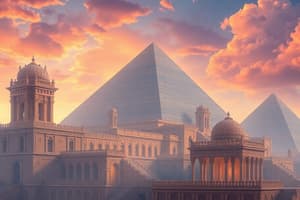Podcast
Questions and Answers
What was the main purpose of Egyptian temples?
What was the main purpose of Egyptian temples?
- To serve as tombs for pharaohs
- To house the largest and most famous pyramid
- To symbolize power, wealth, and immortality
- To provide a connection between the earthly realm and the divine (correct)
Which of the following is true about the Great Temple of Amun-Ra in Luxor?
Which of the following is true about the Great Temple of Amun-Ra in Luxor?
- It was one of the smallest temples in ancient Egypt
- It covered an area of 170,000 square feet (correct)
- It was dedicated to the pharaohs and their consorts
- It was primarily constructed using granite blocks
What materials were commonly used in the construction of pyramids?
What materials were commonly used in the construction of pyramids?
- Limestone and granite (correct)
- Quartz and basalt
- Copper and bronze
- Marble and sandstone
What purpose did the pyramids serve?
What purpose did the pyramids serve?
What were obelisks often made of?
What were obelisks often made of?
Where were hieroglyphics often inscribed?
Where were hieroglyphics often inscribed?
What was the purpose of mortuary complexes?
What was the purpose of mortuary complexes?
What did obelisks symbolize?
What did obelisks symbolize?
Which structures were often part of mortuary complexes?
Which structures were often part of mortuary complexes?
What was the function of hieroglyphics in mortuary complexes?
What was the function of hieroglyphics in mortuary complexes?
Flashcards are hidden until you start studying
Study Notes
Egyptian Architecture: A Journey Through Temples, Pyramids, Obelisks, Hieroglyphics, and Mortuary Complexes
Egyptian architecture is a fascinating blend of symbolism, creativity, and engineering marvels, reflecting the beliefs and culture of the ancient Egyptians. This article delves into the intriguing elements of Egyptian architecture, uncovering the secrets of their temples, pyramids, obelisks, hieroglyphics, and mortuary complexes.
Temples
Egyptian temples were designed as sacred spaces for the worship of gods, serving as a connection between the earthly realm and the divine. They were built with an impressive scale, with the most significant temples measuring over 30,000 square feet. The Great Temple of Amun-Ra, located in Luxor, is one of the most famous examples, spanning 170,000 square feet. Temples were often constructed with a series of courts, halls, and sanctuaries, each dedicated to specific gods.
Pyramids
Pyramids are perhaps the most iconic structures associated with ancient Egypt. These enormous, triangular structures were built as tombs for pharaohs and their consorts, with the largest and most famous being the Great Pyramid of Giza. Constructed as a symbol of power, wealth, and immortality, pyramids were built using limestone and granite blocks, with the largest weighing an average of 2.5 tons. They were also designed with a series of chambers and shafts, leading to the burial chamber where the mummy was placed.
Obelisks
Obelisks are tall, slender monuments with a pyramid shape, tapering towards a pyramidion at the top. They were often erected in pairs, with one placed near the entrance of a temple and the other in the temple's courtyard. Obelisks were made of a single piece of stone, with the most famous examples being the Cleopatra's Needle in London and New York City.
Hieroglyphics
Hieroglyphics, the ancient Egyptian system of writing, were a combination of symbols and logographic characters. They were used to record history, religious rituals, and everyday life. Hieroglyphs were often inscribed on temple walls, tombs, and other significant structures, providing a visual record of ancient Egyptian culture and history.
Mortuary Complexes
Mortuary complexes were designed to provide a final resting place for the pharaohs and their consorts, as well as to serve as a symbol of their power and wealth. These complexes often included a series of structures, including the pyramid, a temple dedicated to the pharaoh, and a village for the workers who built the complex. Mortuary complexes were also decorated with hieroglyphics, depicting the pharaoh's life and the rituals performed to ensure their journey to the afterlife.
In conclusion, Egyptian architecture is a testament to the creativity, engineering skills, and cultural beliefs of the ancient Egyptians. From the magnificent temples dedicated to their gods to the awe-inspiring pyramids built as tombs for their pharaohs, these structures continue to fascinate and inspire visitors to this day.
Studying That Suits You
Use AI to generate personalized quizzes and flashcards to suit your learning preferences.




